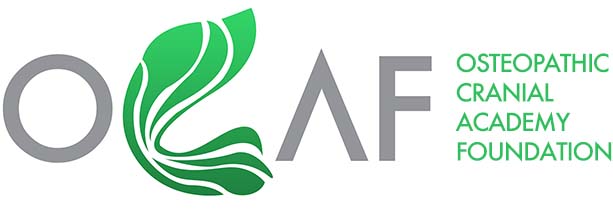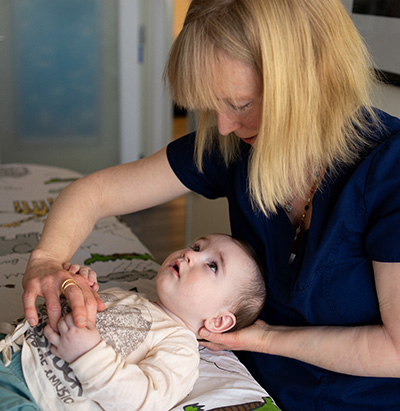Frequently Asked Questions About Osteopathy
What Medical Conditions Benefit
from Cranial Osteopathy?
Some common issues treated with Osteopathy include:
Pediatric Problems Somatic pain Systemic Problems
Colic
Spitting Up
Sucking Difficulty
Delayed Development
Birth Trauma
Cerebral Palsy
Learning Disorders
Pregnancy
Back Pain
Groin Pain
Digestive Upset
Edema
Neck Problems
Back Problems
Sciatica
Headaches
Joint Pain Syndrome
Traumatic Injury
Overuse Syndrome
Respiratory Illness
Asthma
Allergies
Bronchitis
Pleurisy
Neurologic Syndromes
Digestive Disorder
Genitourinary Problems
Chronic Infectious Disease
Head Trauma
Post Concussion Syndrome
Seizures
Ear Nose Throat Problems
Chronic Ear Infection
Recurrent Sore Throats
Frequent Colds
Sinusitis
Additional Questions About Osteopathy
What is Osteopathy?
Osteopathy (including Cranial Osteopathy) takes advantage of the body’s natural tendency to strive toward a state of health and homeostasis. A much in demand specialty, the Osteopath is trained to palpate (feel) the body’s “living anatomy” (i.e. flow of fluids, motion, texture of tissues, and structural makeup). They address health problems with a non-invasive system of medicine called, “Osteopathic Manual Medicine” in order to restore normal function in areas impaired by trauma, chronic illness, acute health problems, etc.
Why Choose An Osteopath?
What is the Difference Between a DO and an MD?
DOs and MDs are both fully licensed physicians who are authorized to prescribe medication and perform surgery on patients of all ages. While attending their own medical schools, DOs are responsible for the same academic discipline as their MD colleagues and receive an additional 300 to 500 hours in the study of the body’s musculoskeletal system. Physicians who wish to pursue this field and become a Cranial Osteopath must train an additional five years in practice just to be eligible for certification testing in this area.
Why Choose a DO Instead of an MD?
To understand why approximately 25,000,000 Americans prefer Osteopathic physicians (DOs) over allopathic physicians (MDs), it is important to look at the similarities between the two, and then the differences. The time spent in medical school and residency programs is virtually identical for DOs and MDs. DOs spend four years in medical school, followed by a year-long rotating internship in Osteopathic hospitals. If they choose to specialize, residency programs are available in the full range of specialties. Both MDs and DOs must take state licensing exams to become practicing physicians; in many states the exam is the same.
It is the focus within the medical training that the differences between DOs and MDs start to appear. Osteopathic medical education places more emphasis on preventive medicine, body structure, Osteopathic treatment and the importance of family practice. More than 75% of the DOs in the United States are in family practice, as opposed to only 25% of the MDs.
Osteopathic physicians are more likely to view a patient as a whole person, taking into account not just the physical symptoms, but also lifestyle, emotional well-being, and environment.
This philosophical debate whether to focus on the patient’s disease or the total patient precedes DOs and MDs. It goes back to the beginnings of medical history when Hippocrates, the “father of medicine” believed in focusing on the patient. The rival Cnidian philosophy focused only on the disease itself.
Finally, the differences are highlighted when it comes to treatment.
Osteopathic physicians, also trained in the use of drugs and surgery, believe strongly in the self-regulating, self-healing, and self-repairing ability of the body. DOs are more likely to promote the body’s own ability to heal itself through means as safe, non-intrusive and with as few side effects as possible. Osteopathic Manual Medicine (OMM) is often used as a primary healing tool.
Many patients choose DOs because they are more comfortable with the philosophies and treatments of Osteopathy. Others may not be as aware of the difference in medical philosophies, but they return to DOs again and again. For these patients, the reason is simple. It works.
Osteopathic Medicine: Some Facts
- Osteopathic physicians emphasize that all body systems, including the musculoskeletal system, operate in unison. By recognizing the critical relationship between body structure and body function, the DO is trained to recognize that a disturbance in one system can alter the functions of another system and/or all systems.
- DOs focus not just on one symptom or complaint, but on the whole patient– including lifestyle, environment, diet, fitness, and emotional wellbeing.
- Osteopathic manual treatment of the musculoskeletal system has been proven to be a successful treatment technique for many disorders. It can provide a natural alternative to numerous drug therapies.
- 52% of graduating DOs enter primary care, such as family practice, internal medicine, and pediatrics, where they can focus on the whole patient.
How Does Osteopathy Work?
Osteopaths hold to the common sense principle that a patient’s history of illnesses and physical traumas are written into the body’s structure. It is the Osteopath’s highly developed sense of touch that allows the physician to palpate (feel) the patient’s “living anatomy” (i.e. flow of fluids, motion of tissues, and structural make-up). In more clinical terms, a DO can even detect physical problems that fail to appear on an X-ray. The Osteopath’s job is to “set” the body up to heal itself. To restore this normal function, the Osteopath gently applies a precise amount of force to promote movement of the bodily fluids, eliminate dysfunction in the motion of the tissues, and release compressed bones and joints. In addition, the areas being treated require proper positioning to assist the body’s ability to regain normal tissue function. This treatment modality, OMM, is even more gentle when the principles of Cranial Osteopathy are applied and can be used to safely and effectively treat infants, babies, children, and adults.
What Happens in Treatment?
After a thorough evaluation, the patient lies down on the examination table ready for treatment. DOs treat the dysfunction in the patient’s body taking advantage of the body’s natural tendency to strive toward a state of health and homeostasis. Many patients frequently report feeling a deep sense of relaxation, tingling, and/or flow of fluids as their pain is relieved. Although treatment varies, the Cranial Osteopath primarily concentrates on normalizing the body’s “mechanism” or put in more clinical terms, The Five Components of the Primary Respiratory Mechanism (as pioneered by William G. Sutherland, DO).
Since the late 1800s, DOs have been able to successfully diagnose and treat medical problems with their hands, much to the disbelief of many of their MD colleagues.
How Does the Body Treat Itself?
The rhythmic motion of the brain and spinal cord along with that of normal breathing is transmitted to the rest of the body through the continuity of membranes (dura and fascia). Fascia is literally one piece of connective tissue that lines the body cavities, surrounds all the muscles, organs, bones, vessels, and nerves, somewhat like a large piece of shrink wrap. The fascia is continuous with the membranes that surround the brain and spinal cord (meninges), thus allowing the different motions (and tension) of the body to be transmitted everywhere. This motion gently pulls and lets go on all the areas of the body in order to work strains and tissue restrictions structurally free. This is enhanced when a person sleeps as the effects of gravity are reduced.
Can You Treat Babies?
All age groups can be safely treated. The minimum age of a patient a DO treats will depend upon their training, experience, and confidence with that particular age group. A DO certified in Osteopathy in the Cranial Field (OCF) usually is comfortable in treating all age groups and can do so very safely. In fact, Cranial Osteopathy is one of the safest treatment modalities that there is for all pediatric patients: newborns, infants, babies, and children.
How Long Does it Take to Get Better?
A chronic condition often takes years to develop. With this in mind, it stands to reason that it will require time to resolve: the ratio is often one month of treatment for every year of illness. (Although every body has its own time table, this is the average course of treatment). For a patient with an acute problem (flu, muscle strain, etc.), the course of treatment is shorter because the condition is not as deep as a chronic illness. Much is also dependent on a patient’s level of vitality (i.e., immune system). In other words, a patient in generally good health will respond more quickly to treatment than a patient with lower vitality (i.e., weakened immune system).
How Popular is Osteopathy?
Osteopathy has changed the lives of such well-known figures as John D. Rockefeller, Henry Kissinger, former presidents Franklin Delano Roosevelt, Dwight Eisenhower and John Fitzgerald Kennedy. The growing demand for Osteopathic services among our population reflects an increasing desire by patients to resolve health problems without drugs or surgery. Osteopathic Medicine continues to gain national attention and remains the fastest growing health profession in both the U.S. and abroad.
How Did Osteopathy Begin?
Civil War Surgeon Andrew Still, MD (1828 to 1917) founded Osteopathy on the principle that the best way to fight disease was by naturally stimulating the body’s immune system. In the late 1800s, Dr. Still broke from traditional medicine when he decried the widespread practice of purging and leeching. For his efforts, Dr. Still was ostracized from his profession. But, undeterred, Dr. Still spent years developing a healing science that could restore normal function and freedom of tissues through a practitioner’s sensitive manual diagnosis and manipulation of tissues and fluid. He founded a school for Osteopaths over the objections of his colleagues. Dr. Still maintains a loyal following of physicians throughout the world. His work has been advanced by several generations of Osteopaths, which includes the founder of Osteopathy in the Cranial Field, William Garner Sutherland, DO. Their reward for practicing Osteopathy has been the recovery and well being of many of their patients – babies to adults.
What Does Osteopathy Treat?
Treatment is aimed at the structural problems present, not the disease entity. By removing the obstructions to health, Osteopathic Physicians are able to treat virtually any illness or trauma. Their philosophy is the body is a unit whose parts integrally affect each other. Therefore, dysfunction in one area affects other areas as well. For example a young man suffering from pain due to a cervical disc problem wanted to know why his practitioner was spending time treating his legs when it was his neck that hurt. The doctor explained that due to a past traumas the man’s legs was pulling on his neck, restricting its motion, and that unless he freed up the area, the pain would persist. Much to the patient’s amazement, a great deal of his pain disappeared before his neck was treated. Please see the table below for an abbreviated list of common problems treated.

